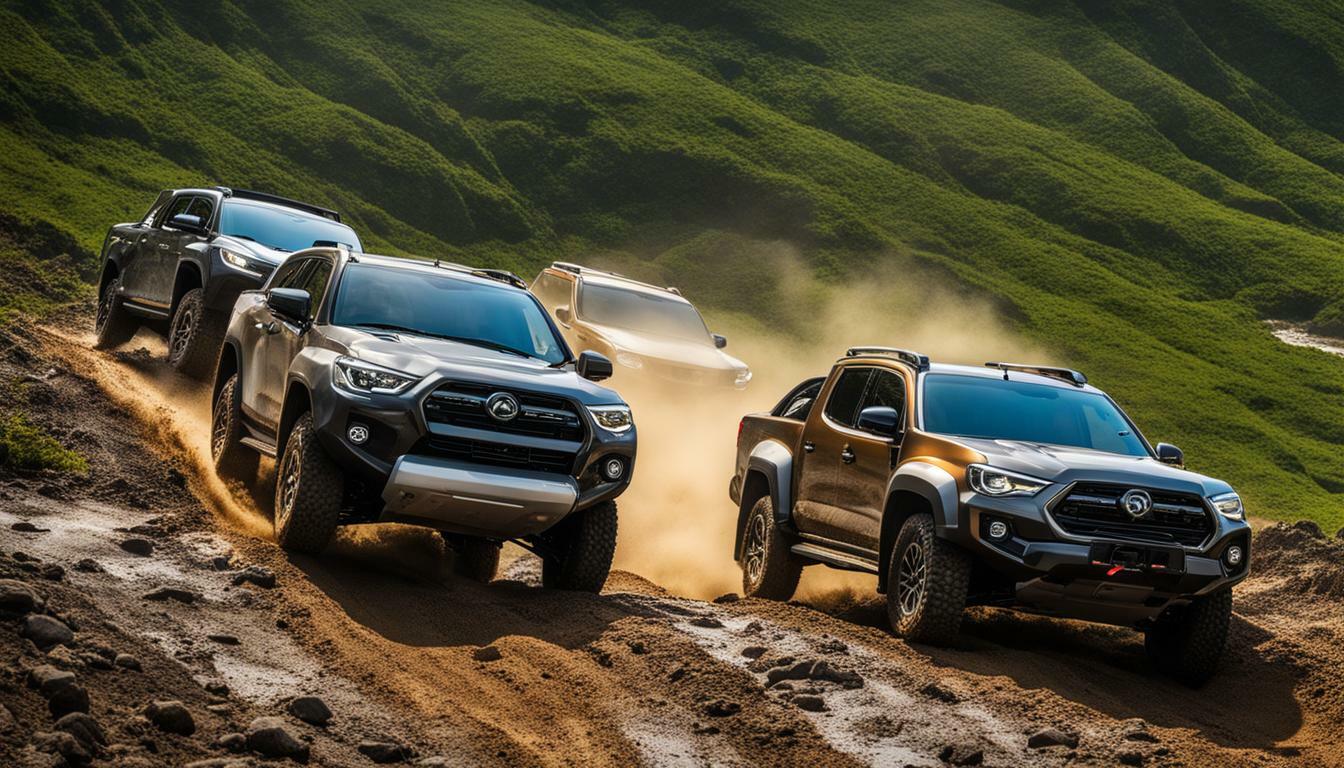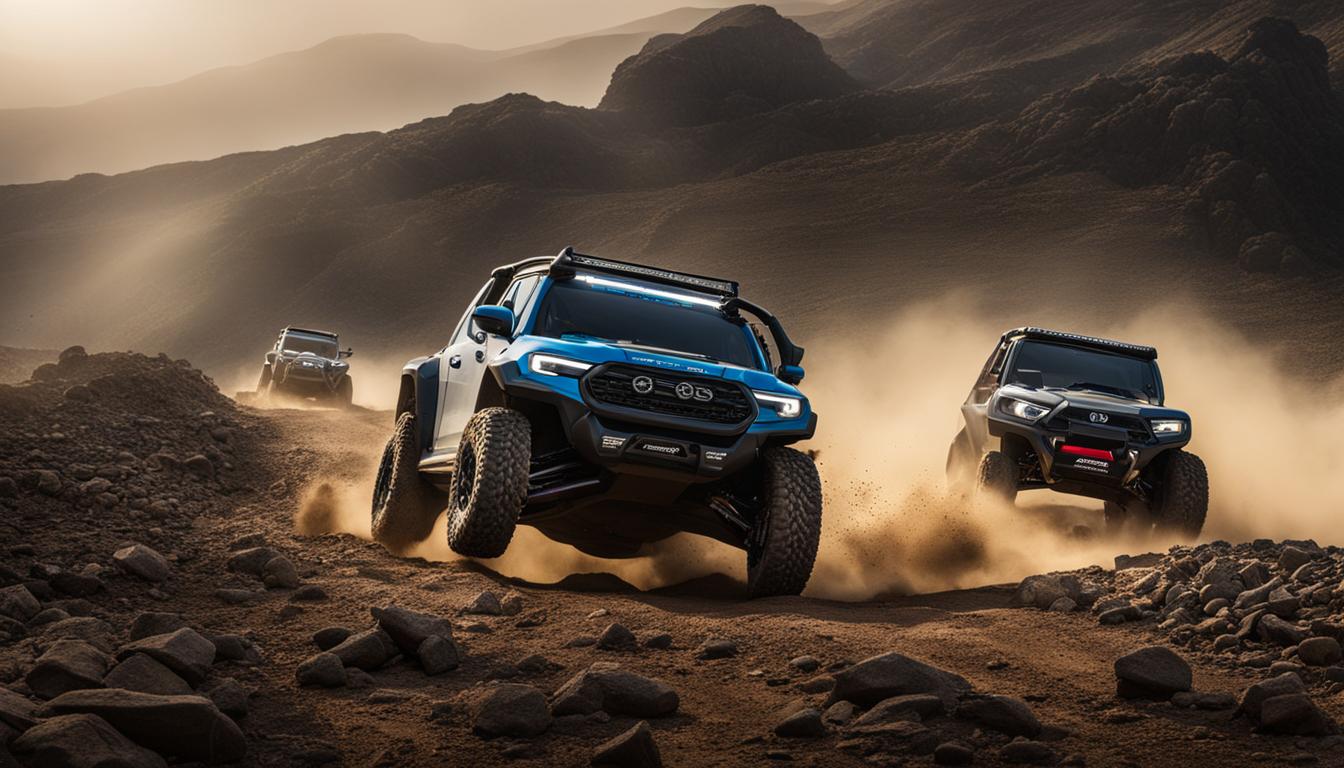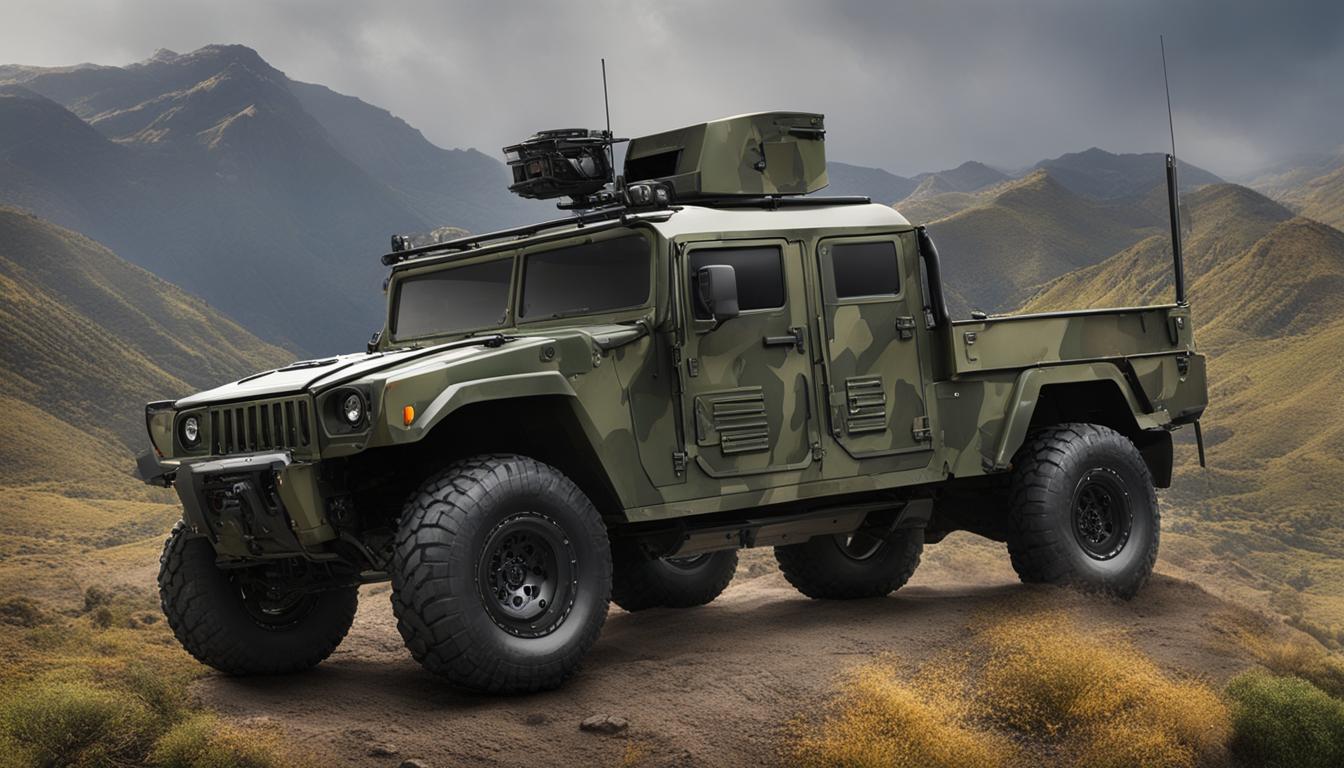When it comes to off-road vehicles, understanding the difference between 4WD and AWD is crucial for a successful and thrilling off-road experience. Off-road adventures require vehicles with capable drivetrains that can tackle challenging terrains with ease. While both 4WD and AWD provide enhanced traction and stability, they operate differently and offer varied advantages in off-road conditions.
Key Takeaways:
- AWD systems distribute power to all four wheels and automatically adjust for wheel slippage, making them suitable for on-road use and mild off-roading.
- 4WD systems require manual shifting into 4WD modes and can send equal power to all four gears, making them ideal for heavy-duty off-road use and extreme conditions.
- 4WD vehicles have two distinct modes: 4-Hi for higher speeds and 4-Lo for slower, extreme off-road conditions.
- 4WD is the preferred choice for serious off-road adventures, providing maximum traction and control in challenging terrains.
- AWD is better suited for on-road use and snowy conditions, offering enhanced stability and handling.
How AWD Works for Off-Road Use
All-Wheel Drive (AWD) systems are designed to provide constant power to all four wheels, making them an ideal choice for light off-roading and on-road driving. Unlike Four-Wheel Drive (4WD) systems that require manual shifting into different modes, AWD systems are always active, continuously distributing power to each wheel. This feature allows AWD vehicles to automatically adjust for wheel slippage, providing better traction and stability in various driving conditions.
When driving off-road with AWD, the power distribution to each wheel is managed by advanced electronic systems. These systems monitor wheel slippage and adjust the torque sent to individual wheels accordingly. For example, if one wheel loses traction, the AWD system can transfer power to the wheels with better grip, helping the vehicle maintain momentum and conquer challenging terrain.
AWD systems excel in providing improved handling and grip on slippery surfaces, such as wet roads or snowy conditions. They offer enhanced stability and control, enabling drivers to navigate through mild off-road trails with ease. However, it’s important to note that AWD vehicles have limitations when it comes to extreme off-roading. Their design is primarily focused on on-road performance, and they may not have the necessary ground clearance, suspension, or robust drivetrain components found in dedicated 4WD vehicles.
AWD vs 4WD: Which is Right for You?
When considering the choice between AWD and 4WD for off-road adventures, it ultimately depends on the type of terrain you will be tackling. If you’re planning to venture into extreme off-road conditions or require maximum traction for heavy-duty tasks, then a 4WD vehicle is the better option. 4WD systems allow for manual shifting into low-range 4-Lo mode, providing enhanced torque and crawling capabilities in challenging terrains. They also feature robust construction, including durable driveline components, heavy-duty axles, and locking differentials, making them better suited for rugged off-road use.
On the other hand, if your off-road excursions are mainly limited to mild trails or you live in an area with inclement weather conditions, an AWD vehicle can offer the versatility you need. AWD systems provide better traction and stability on slippery roads or light off-road trails, while still offering the convenience of on-road performance. They are also more fuel-efficient compared to 4WD vehicles, making them a practical choice for everyday commuting.
| AWD | 4WD |
|---|---|
| Ideal for on-road and light off-road use | Designed for extreme off-road conditions |
| Constant power distribution to all wheels | Requires manual shifting into 4WD modes |
| Suitable for mild off-roading and inclement weather conditions | Offers enhanced traction and crawling capabilities |
| Adjusts power distribution based on wheel slippage | Sends equal power to all four gears |
In conclusion, AWD systems are designed to provide constant power to all four wheels, making them well-suited for light off-roading and on-road driving. They offer improved traction and stability on slippery surfaces, making them an excellent choice for mild off-road trails or areas with inclement weather. However, for serious off-road adventures or tasks that require maximum traction, a 4WD vehicle with manual shifting capabilities and robust construction is the preferred option.
The Power of 4WD in Extreme Off-Roading
When it comes to conquering extreme off-road challenges, Four-Wheel Drive (4WD) systems stand out, thanks to their ability to provide equal power to all wheels and withstand extreme conditions. Unlike All-Wheel Drive (AWD) systems, which are “always on” and automatically adjust power distribution, 4WD requires manual shifting into specific modes for optimal performance.
4WD vehicles are built to tackle the toughest terrains. With their ability to send equal power to all four gears, they ensure maximum traction and control, even in the most demanding off-road conditions. Whether you’re navigating through deep mud, climbing steep inclines, or traversing rocky terrains, 4WD systems provide the necessary torque to overcome obstacles.
These systems offer two distinct modes: 4-Hi and 4-Lo. The 4-Hi mode is designed for higher speeds, making it ideal for cruising through sandy deserts or navigating dirt trails. On the other hand, the 4-Lo mode is specifically suited for slower, extreme off-road conditions, such as crawling over boulders or descending treacherous slopes. The low gearing ratio in 4-Lo mode provides maximum torque, allowing for precise control and maneuverability.
Pros and Cons of 4WD and AWD in Off-Road Vehicles
While 4WD systems excel in extreme off-road situations, AWD systems have their own advantages. AWD is “always on,” continuously distributing power to all four wheels based on traction needs. This makes AWD vehicles well-suited for on-road use and mild off-roading.
One key advantage of AWD is its ability to automatically adjust power distribution to compensate for wheel slippage. This ensures optimal traction on slippery surfaces, making AWD vehicles more suitable for snowy or icy conditions. Additionally, AWD systems provide enhanced stability and control during everyday driving, offering a smoother and more confident on-road experience.
However, AWD systems have limitations when it comes to extreme off-roading. Their continuous power distribution may not provide the same level of torque and control as 4WD systems in challenging terrains. AWD vehicles may struggle to overcome deep mud, steep inclines, or rugged trails with the same ease as their 4WD counterparts. Therefore, if you’re planning to embark on serious off-road adventures, a 4WD vehicle would be the preferred choice.
In summary, while AWD is well-suited for on-road use and mild off-roading, 4WD is the go-to drivetrain for extreme off-road challenges. With its ability to provide equal power to all wheels and withstand the harshest conditions, 4WD offers the necessary traction, control, and torque to conquer the most demanding terrains.
| 4WD | AWD |
|---|---|
| Manual shifting into specific modes | Always on, continuously adjusting power distribution |
| Equal power distribution to all four gears | Power distribution based on traction needs |
| Designed for heavy-duty off-road use | Well-suited for on-road use and mild off-roading |
| Optimal for extreme off-road conditions | Enhanced stability and control on slippery surfaces |
4WD Modes and Their Usage
When it comes to off-road vehicles, having the right traction and control is crucial for navigating through challenging terrains. This is where 4WD (Four-Wheel Drive) systems come into play. 4WD systems offer two specific modes, namely 4-Hi and 4-Lo, each catering to different off-road situations, allowing for optimal traction and control.
The 4-Hi mode, also known as the high-range mode, is designed for higher speeds and less extreme off-road conditions. In this mode, power is evenly distributed to all four wheels, allowing for improved grip and stability. It is ideal for traversing gravel roads, muddy trails, and other moderately challenging terrains.
On the other hand, the 4-Lo mode, or the low-range mode, is specifically engineered for slower, more extreme off-road conditions. This mode provides maximum torque to help overcome steep inclines, deep mud, and rocky surfaces. The enhanced power in 4-Lo mode allows the vehicle to crawl over obstacles with ease, providing superior traction and control.
It is important to understand that the choice between 4-Hi and 4-Lo depends on the specific terrain and conditions you encounter during your off-road adventure. If you are venturing onto a rugged mountain trail or navigating through deep mud pits, engaging the 4-Lo mode will provide the necessary power and torque to tackle these obstacles. However, if you are driving on a less challenging terrain or need to maintain higher speeds, the 4-Hi mode will be more suitable.
| 4WD Modes | Usage |
|---|---|
| 4-Hi | Higher speeds, moderate off-road conditions |
| 4-Lo | Slower speeds, extreme off-road conditions |
Conclusion
Understanding the difference between 4WD and AWD in off-road vehicles is essential for choosing the right drivetrain for your off-road adventures. While AWD works well for mild off-roading and on-road use, 4WD is the go-to option for tackling extreme off-road challenges.
AWD systems are “always on,” distributing power to all four wheels and automatically compensating for wheel slippage. They are designed for on-road use and are suitable for mild off-roading. With continuous power distribution, AWD provides good traction in various conditions, including snowy roads.
On the other hand, 4WD systems require manual shifting into 4WD modes and can send equal power to all four gears. These heavy-duty drivetrains are designed for extreme off-road use and can withstand harsh conditions. 4WD vehicles have two distinct modes: 4-Hi for higher speeds and 4-Lo for slower, extreme off-road conditions.
When venturing off the beaten path, 4WD vehicles are the better choice. They offer superior torque and traction, allowing you to conquer steep inclines, navigate through deep mud, and overcome other challenging terrains. Whether you’re a thrill-seeking adventurer or a serious off-road enthusiast, having the power and control of 4WD gives you the confidence to tackle any obstacle that comes your way.
FAQ
What is the difference between All-Wheel Drive (AWD) and Four-Wheel Drive (4WD) in off-road vehicles?
AWD systems are “always on,” distributing power to all four wheels and automatically compensating for wheel slippage. 4WD systems require manual shifting into 4WD modes and can send equal power to all four gears.
What are AWD systems designed for?
AWD systems are designed for on-road use and are suitable for mild off-roading. They are ideal for driving in snowy conditions and providing better traction on slippery roads.
Are 4WD vehicles better suited for off-road adventures?
Yes, 4WD vehicles are designed for heavy-duty off-road use and can withstand extreme conditions. They have two distinct modes: 4-Hi for higher speeds and 4-Lo for slower, extreme off-road conditions.
Which drivetrain is better for serious off-road adventures?
4WD vehicles are the better choice for serious off-road adventures, as they offer more control and power distribution in extreme conditions.
When should I use 4-Hi mode?
4-Hi mode is suitable for higher speeds and provides better traction when driving on rough or uneven terrain.
When should I use 4-Lo mode?
4-Lo mode is designed for slower, extreme off-road conditions such as climbing steep hills or traversing through deep mud or sand.
 Skip to main content
Skip to main content


